This method statement describes the overall sequence of the traffic diversions that will be carried out at a construction project site. It also outlines the materials used, machinery and equipment involved for ensuring the works are carried out safely and in compliance with contract requirements.
Terms & Definitions
Competent Person: For the purpose of the relevant statutory provision, a person is deemed to be a competent person where, having regard to the task he or she is required to perform and taking account of the size or hazards (or both of them) of the undertaking or establishment in which he or she undertakes work, the person possesses sufficient training, experience and knowledge appropriate to the nature of the work to be undertaken
Coordinator: A competent person appointed in writing to assist in the undertaking of the duties of the Project Supervisor
Road: any street, lane, footpath, square, court, alley or passage; any bridge, viaduct, underpass, subway, tunnel, overpass, overbridged, flyover, carriageway (whether single or multiple), pavement or footway; any weighbridge or other facility for the weighing or inspection of vehicles, toll plaza or other facility for the collection of tolls, service area, emergency telephone, first aid post, culvert, arch, gulley, railing, fence, wall, barrier, guardrail, margin, kerb, lay-by, hard shoulder, island, pedestrian refuge, median, central reserve, channelliser, roundabout, gantry, pole, ramp, ballard, pipe, wire, cable, sign, signal or lighting forming part of the road; and any other structure or thing forming part of the road and necessary for the safety, convenience or amenity of road users or for the construction, maintenance, operation or management of the road or for the protection of the environment; or prescribed by the authority;
Roadway: That portion of a road which is provided primarily for the use of vehicles
Roadworks: Roadworks means repairs, maintenance, alterations, improvements or installations or any other works to, above or under, a public road
Road Works Speed Limit: A regulatory speed limit applied at a roadworks site for a duration and at a location specified in a Manager’s Order made under Section 10 of the Road Traffic Act 2004
Temporary Traffic Operations Supervisor (TTOS): The person on site with direct responsibility for implementation, maintenance and removal of temporary traffic arrangements
Minor Road: A local roadway less than 5.5m wide with an AADT of less than 1000 vehicles. All other public roads shall be considered to be non-minor roads.
Roadworks Types
This document relates to the following roadworks types. If more than one roadworks type is needed, the design parameters for the higher roadworks type should be used. Guidance on the TTM for these roadwork types is given throughout this document.
Static Type A
These are full-time roadworks that remain in operation in all traffic flow conditions and usually remain in position for a duration typically in excess of 12 hours.
They may remain in position for a number of weeks or months. They typically require a site specific plan but this is not always the case so may include works with a standard TTM layout.
Major roadworks such as a road realignment, road widening, pavement overlay, drainage works, utility installation maintenance or upgrade generally fall in to this category.
These are Type A works because a significant amount of labor, plant and materials are required to carry out the operation.
Additionally a significant portion of the road or roadway is required.
Static Type B
These are roadworks that are of a short duration and where there are one or two vehicles in the operation.
Works are typically maintenance and repair operations, including maintenance of utilities or street furniture and where traffic flow is unrestricted by either traffic volume or weather conditions.
Duration is usually in the region of 12 hours. These works may include a site specific plan or standard TTM layouts.
Type B roadworks typically include sign replacement and minor utility / drainage upgrade and maintenance.
These roadworks normally include three to four road workers. The duration of the works may vary from approximately 15 minutes to a full work shift (12 hours).
Linear works away from junctions may be undertaken using standard TTM layouts, however, for example if there is a drainage access chamber at a junction, then this should be undertaken using a site specific plan.
Static Type C
These are roadworks at discrete locations with a duration of approximately 15 minutes excluding signage setup.
Traffic flow is unrestricted by either traffic volume or weather conditions.
Roadworks such as washing signs, checking utilities and one off road repairs generally fall within the scope of Type C works.
This scope normally includes a maximum of two road workers, one works vehicle and a minimal amount of plant.
Emphasis of controls (as with Type A and B) are built around advanced visibility from the road user to the works, and stopping sight distance.
Both of these increase significantly within Type C Roadworks as traffic speeds increase, in line with the design standards laid down within the design manual for roads and bridges DMRB.
Signs mounted on the works vehicle may be sufficient provided the visibility and stopping sight distances comply with the requirements specified.
Where signs are not mounted on vehicles, a Roadworks Ahead (WK 001) sign should be erected either side of the works.
- These works must be individually separate and distinct and detached from other works.
- They are a single one-off piece of work at any given location;
- Traffic flow must be within the carriageway capacity;
- There must be good visibility; and
- The maximum duration of the works is 15 minutes.
It should be noted that a sequence of pothole repairs does not fall within the scope of Type C works. Such works are classified as a semi-static operation.
Semi Static Operation (SSO)
These are works where the operations are mobile or making short duration stops continuously along a road where static warning signs are used. SSO are permitted for stop durations of up to 15 minutes and are only suitable on Level 1 and 2 roads. These operations need to be unrestricted by either traffic volume or weather conditions and need good visibility.
Examples include hedge cutting, mowing, weeding, minor road surface repairs, installation of road markings or studs, pavement sweeping, cleaning gullies or manholes and litter picking.
Mobile Lane Closures (MLC)
These are works where the operations are mobile or making short duration stops continuously along a road where mobile warning signs and Impact Protection Vehicles (IPV) are used.
MLC are permitted for stop durations of up to 15 minutes and are only suitable on Level 3 roads. MLC need to be unrestricted by either traffic volume or weather conditions and also need good visibility.
Examples include hedge cutting, mowing, weeding, minor road surface repairs, installation of road markings or studs, pavement sweeping, cleaning gullies or manholes and litter picking.
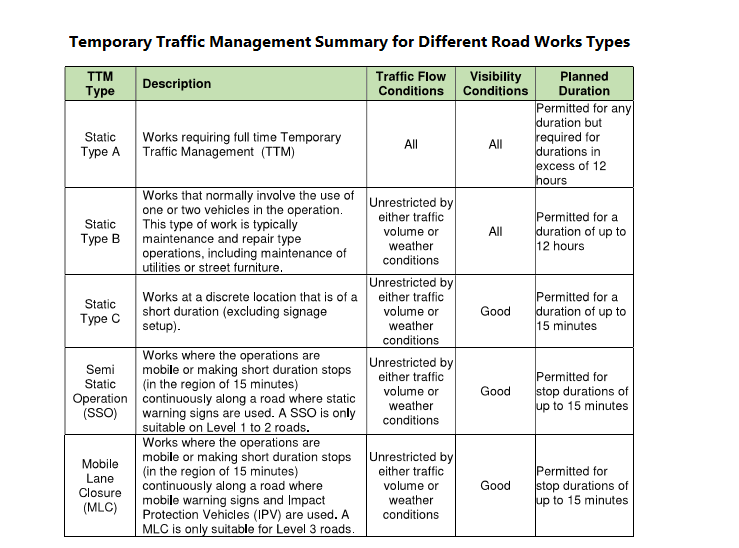
Proposed Roadworks (Traffic) Parameters
Below table outlines where the different roadworks types are permitted and gives brief details on safety zones and training.
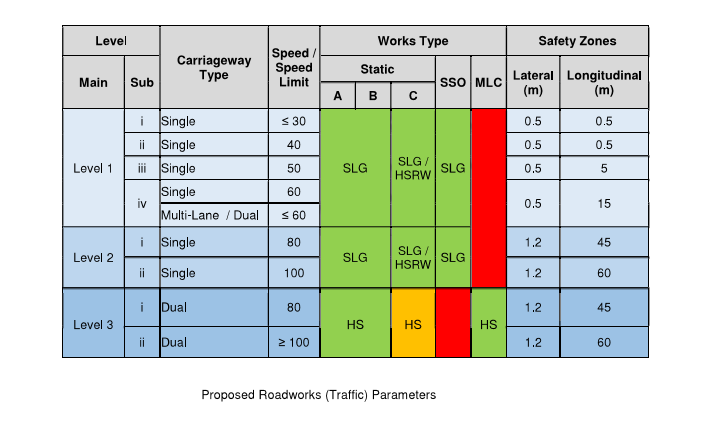
Table Abbreviations
Green– permitted;
Amber– restricted use on Level 3 roads;
Red– not permitted;
SSO– Semi-Static Operations;
MLC– Mobile Lane Closures;
SLG – Signing, Lighting and Guarding at Roadworks Construction Skills Certification Scheme;
SRW– Health and Safety at Roadworks Construction Skills Certification Scheme; and
HS– High Speed Roads Skills Certification Scheme.
Temporary Traffic Management TTM Elements
The purpose of this section is to identify and describe the various TTM elements that are commonly used during operations.
These Include:
- Advance Signing;
- Lead-in Taper;
- Advance Central Coning;
- Longitudinal Cone Run;
- Safety Zone;
- Works Area; and
- Exit Taper.
The TTM Elements are shown together in below figure and each element is described in further detail thereafter.
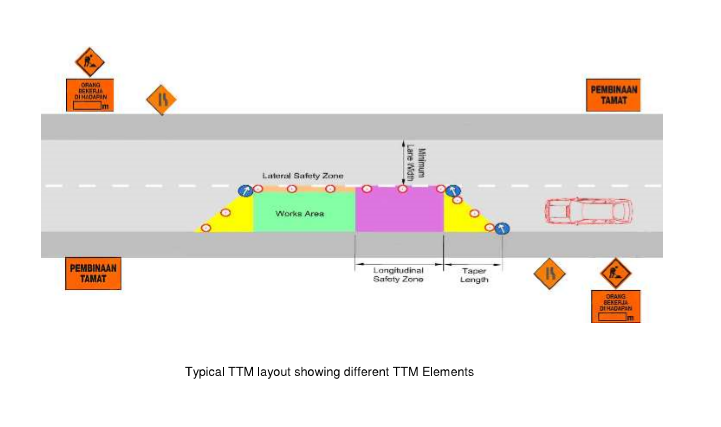
Temporary Traffic Management Method Statement
Advance Signing
Advance signing must be provided to warn road users of the presence of roadworks ahead.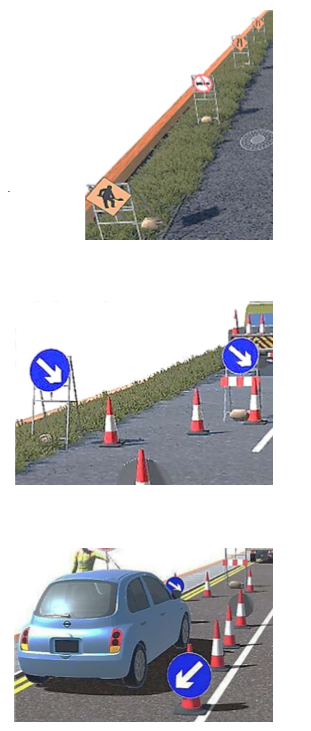
Setting out must start with the Roadworks Ahead sign.
Other signs should then be set out in sequence moving towards the works area.
Signage should not be positioned where they are hidden from view by other temporary signs, existing features or vegetation.
Additionally they should not interfere with the visibility of permanent signs, merges, diverges, etc.
Lead-in Taper
A lead-in taper is provided to deflect road users around the works area.
They must be defined with traffic cones or alternatively temporary barriers.
The taper area should be treated the same as a safety zone with regard to restrictions of use and access.
The first cone must include a Keep Left/Right arrow. The last cone to be placed must also include a Keep Left/Right arrow.
Advance Central Coning
Advance central coning is the line of cones used in advance of a lead-in taper.
Where practicable the length of advance central coning is 20m in rural areas and 10m in urban areas.
The purpose of the central coning is that if a large vehicle is at the head of the queue the cones should extend beyond the back of that vehicle giving an indication of roadworks ahead and prevent overtaking of that vehicle.
Funneling (narrowing) of the advance central coning may be done however the narrow end of the funnel should not be less than 3.3m.
Longitudinal Cone Run
A longitudinal cone run is the line of cones that runs past the longitudinal safety zone and works area.
It must be defined with traffic cones or alternatively temporary barriers.
The first and last cones must include a Keep Left / Right arrow.
Longitudinal Safety Zone
A longitudinal safety zone is provided between the lead-in taper and works area.
It shall be kept clear of operatives, materials and vehicles and shall only be entered to maintain the TTM layout.
The boundary of the safety zone should always be clearly defined by traffic cones or an approved temporary barrier.
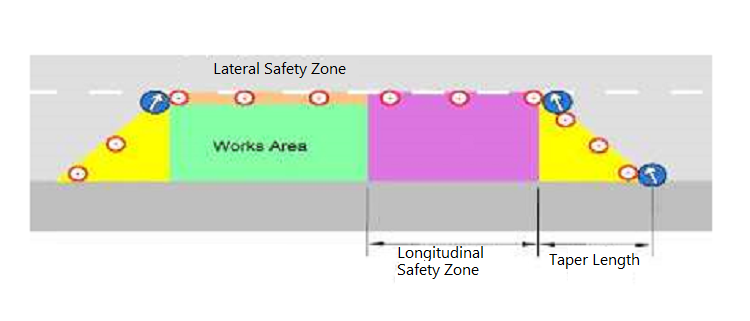
Lateral Safety Zone
A lateral safety zone is provided between the works area and the live traffic lane.
It shall be kept clear of operatives and materials and shall only be entered to maintain the TTM layout.
The outer boundary of the safety zone should always be clearly defined using traffic cones or an approved temporary barrier.
Traffic cones are included as part of the lateral safety zone.
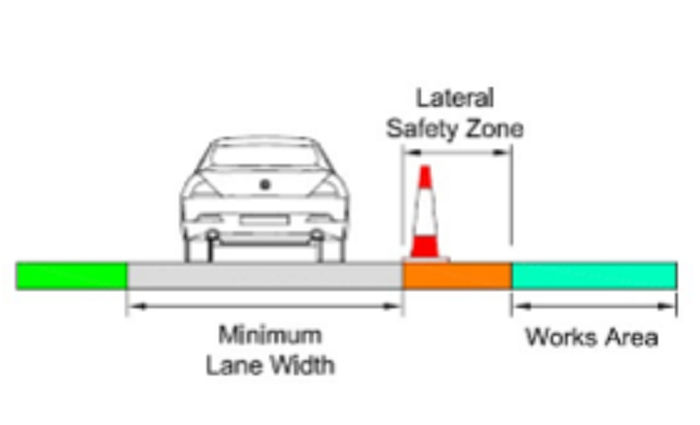
Works Area
The works area is the actual area required to carry out the works and it includes the space required for storing vehicles, materials and equipment.
The works area is protected by a longitudinal and lateral safety zone.
Exit Taper
An exit taper is provided from the end of the works area and lateral safety zone.
It must be defined with traffic cones or alternatively temporary barriers.
The first cone must include a Keep Left/Right arrow.
Roles and Responsibilities
The scale and type of TTM will determine the manpower required. The roles, responsibilities and qualifications of the TTM crew are as follows:
Temporary Traffic Operations Supervisor (TTOS)
Supervise the site;
Select the appropriate standard TTM layout;
Ensure the implementation of the appropriate standard TTM layout or site specific TTM Plan on site;
Must be on site during TTM installation, maintenance, modification and removal;
Monitor and ensure TTM remains In place as detailed In the TTM plan and correct if necessary; and
Maintain TTM site records.
TTM Operatives
Set out, modify and remove TTM under instruction from the TTOS;
Monitor and ensure TTM remains in place as detailed in the TTM plan and correct if necessary;
Make minor alterations to the TTM (example replace, re-stand and clean delineation devices);
Do not alter the TTM unless under the supervision and direction of the TTOS;
Cooperate with the TTOS; and
Report TTM defects to the TTOS.
Employee Training
The following training should be provided:
All Employees: Safe Pass; and Manual handling.
Operatives: Where a TTOS is not present on site, at least one operative on site should hold a one day Health and Safety.
However a TTOS must be present for TTM setup and removal.
Other Training: Employer policy may identify that specific additional training should be provided.
A non-exhaustive list includes the following:
- Traffic management banksman;
- Convoy operations;
- Stop and Go operations;
- Temporary traffic signals; and
- Traffic management equipment manual handling.
Warning Signs
Warning signs warn road users of roadworks activity and hazards on the road ahead. These signs are generally diamond shaped with a black legend on an orange background.
Signs should be made of retro-reflective material, be in good condition and be visible to the road user. The first sign that must be put in place is the Roadworks Ahead sign.
Regulatory Signs
Regulatory signs give mandatory instruction or place restrictions on road users.
They are generally circular with the exception of yield and stop signs.
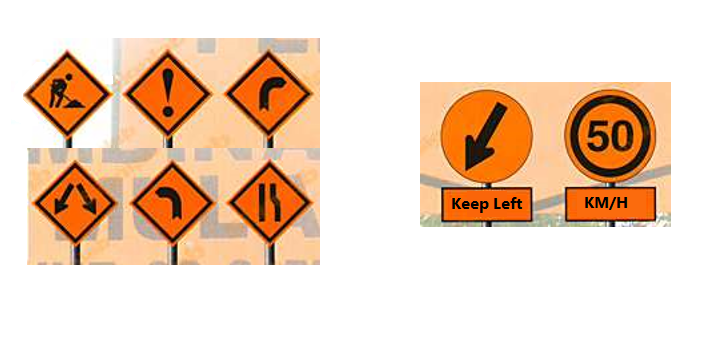
Information Signs
Information signs give directions and other information to road users.
They are generally rectangular in shape.
Control Devices for Temporary Traffic Management
Cones
Cones are red with a reflective band used to delineate the works zone and direct road users through the roadworks site.
The minimum cone height on a single carriageway road is 750mm.
Cones should be stable enough to remain upright and should be kept clean to ensure visibility.
Cones should have a weighted detachable base. The reason for this is that if the cone gets struck by a vehicle, it will not become a hazard, as the weighted base will remain on the ground.
Secondary weighted bases can be used to add ballast to cones where there is a tendency for them to get blown over.
Sand bags must not be used as ballast on cone bases.
Cones without a reflective band or if the band is damaged are not acceptable.
Cones may be used as sign stands where space is restricted and the use of A frames is problematic.
This may be useful in urban areas where space is restricted by urban furniture, parked cars or other obstructions or in rural areas where narrow verges are present.
Signs should be attached to cones via brackets, slings or elasticated bands. The complete sign face and any supplementary plate must be visible to the road user
Installation of signs upside down is not acceptable.
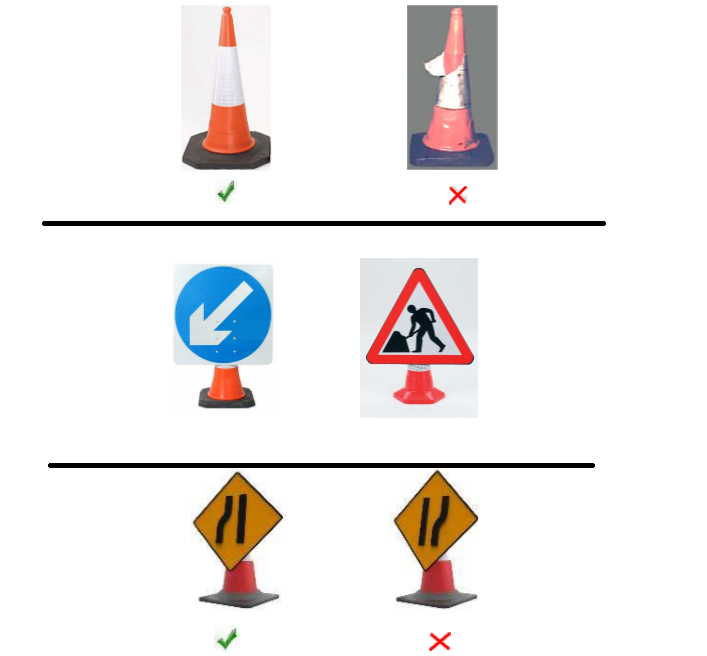
Pedestrian Barriers
Pedestrian barriers should be used to define temporary footways at roadworks.
They should have a minimum 150mm thick high visibility bar between 1.0 and 1.2m from the ground, measured to the top of the bar. They should have a minimum 150 to 250mm thick tapping rail a maximum of 200mm measured from the ground, to the bottom of the rail.
Pedestrian barriers should have reflective strips, be secure enough to keep children out of the roadworks site and should be linked together so that they cannot be easily separated.
Key points include the following:
- Easy to use, assemble and store;
- Linking allows barrier sections to be easily joined together;
- Provide good stability; and
- Legs may present a trip hazard.
Water Filled Barriers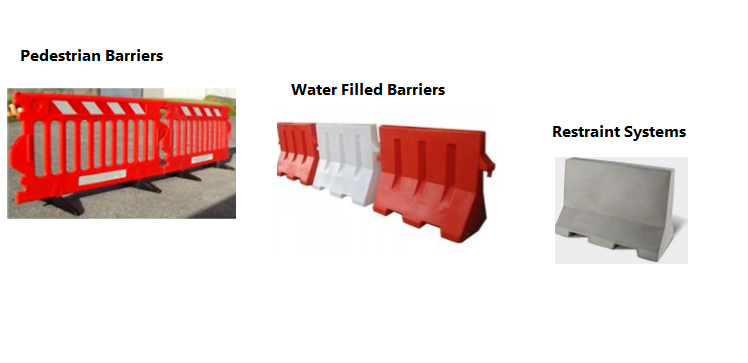
Water filled barriers are used to define a works zone or a temporary footway at roadworks.
Key points include the following:
- Easy to use, assemble and store;
- Linking allows barrier sections to be easily joined together in straight or curved shape;
- Easy to fill and drain;
- Provide good stability when full;
- Good impact resistance;
- Can be easily moved when not filled; and
- Do not present a trip hazard.
Restraint Systems
Restraint systems are used at roadworks to contain errant vehicles, protect roadworks sites, channel and redirect traffic, form a median barrier and for contra flow situations.
It is important that the sections are linked together and that this is done correctly.
In some scenarios, such as at a deep excavation, a restraint system may be used to provide enhanced protection compared to cones, railings or water filled barriers.
Lamps, Lighting and Reflectors
Lighting is provided at roadworks to further define the works area for road users and to provide visibility for works during hours of darkness.
Sufficient lighting should be provided however it should not dazzle oncoming traffic.
The different types of lighting used at roadworks include the following:
- Steady state lamps;
- Flashing including sequential lighting;
- Rotating reflectors; and
- Temporary overhead lighting.
Warning Lights
Warning lights must be installed in unlit areas for Type A works in accordance with Chapter 8 of the Traffic Sign Manual TSM.
Warning lights should be installed on cones, ensuring the reflective sleeve of the cone is not masked.
Anti-vandalism cages must not be used on warning lights on Level 3(ii) roads.
Warning lights may be steady state, flashing and sequential flashing.
Steady state warning lights must be used unless highlighting a specific hazard.
Flashing lamps must only be used where attention needs to be drawn towards a hazard.
Flashing warning lights are typically used at the following locations:
- At the first advance warning sign to notify the road user of the approaching roadworks;
- At the start and end of tapers;
- At site access/egress points;
- At ramps; and
- At start of narrow lanes.
Sequential flashing warning lights may only be used on the lead-in taper.
Use of sequential flashing warning lights at any other taper within the TTM Layout will cause confusion for the road user.
Warning lights may be replaced by rotating reflectors on the longitudinal run of cones only.
Variable Message Signs
Variable Message Signs (VMS) are used to provide regulation, warning, and information messages to road users.
They should be located so that they do not become a hazard to either road users or road workers.
Temporary Traffic Signals
Temporary traffic signals are mainly used where traffic is reduced to shuttle working. They can be used both during daytime and at night.
They are particularly useful where work sites are left unmanned overnight. They should be capable of running a number of different phases.
Time based signals are generally adequate for the majority of works.
In certain conditions Temporary Traffic Signals should be vehicle actuated. These include the following: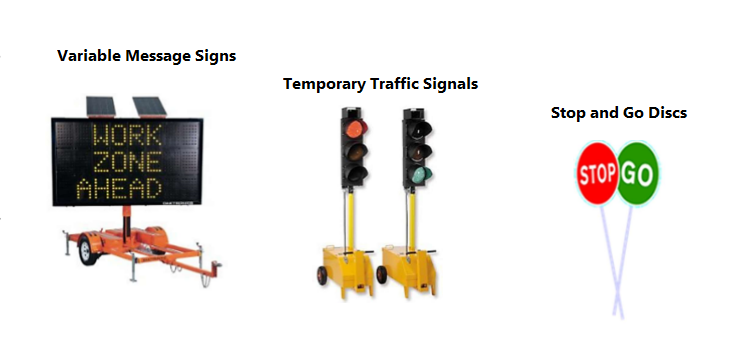
- Type A and B works on National and Regional Routes;
- Where a Stop and Go system is required but it is not possible to deploy a Stop and Go operator; and
- On narrow roads (lateral safety zone less than 1.2m) where vehicles must be brought to a stop before entering the shuttle, and it is not possible to deploy a Stop and Go operator.
Vehicle actuated Temporary Traffic Signals are generally not advisable within urban areas.
Where possible the site should be provided with Stop and Go discs as backup in case of traffic light failure.
Temporary traffic signals are preferable to manually operated TTM methods because it means operatives are not exposed to live traffic.
Stop and Go Discs
Stop and Go (RUS 060: Stop and Go Disc- STOP and RUS 061: Stop and Go Disc- GO) discs are used at plant crossings or short lengths of working.
The discs consist of a double sided round panel on a batten. One side of the disc states Stop on a red background and the other side states Go on a green background.
The pole must be a minimum height of 1.5m above the adjacent pavement, but may need to be higher in certain circumstances, to maintain visibility.
Stop and Go discs can be used manually or automatically. For works of 20m in length or less, a single operator may use them manually.
For works longer than 20m, automatic use by a single remote operator is possible. For works longer than 200m, two operators are required with one located at each end of the works area.
Manual Stop and Go discs are particularly advantageous where visibility is not a problem.
Stop and Go discs should be replaced with temporary traffic signals for night working. If they are required at night, lighting must be provided however floodlights should not dazzle oncoming road users.
Sequence of Operations & Standard Operating Procedure
A Standard Operating Procedure (SOP) details how a particular task or activity should be carried out safely. It may include, but is not limited to the following:
- Work start and finish times;
- How and where vehicles are to be parked;
- How and where equipment and materials are to be delivered and stored;
- Methodologies, procedures and sequencing for setting-out, placement, modification and removal of TTM equipment;
- Checks and maintenance procedures including arrangements for replacing damaged equipment;
- Procedures for working at night; and
- Contingency plans for possible problems such as adverse weather.
A SOP may not be required for short duration routine works however it may be required for more complex longer duration works.
Vehicles
The type and number of TTM vehicles used will vary depending on the TTM plan, location and operation to be carried out.
The types of vehicles used include vans, pick-up trucks, Impact Protection Vehicles (IPV) and quad bikes. These can be used as advance warning vehicles, IPVs, working vehicles or lead pilot vehicles.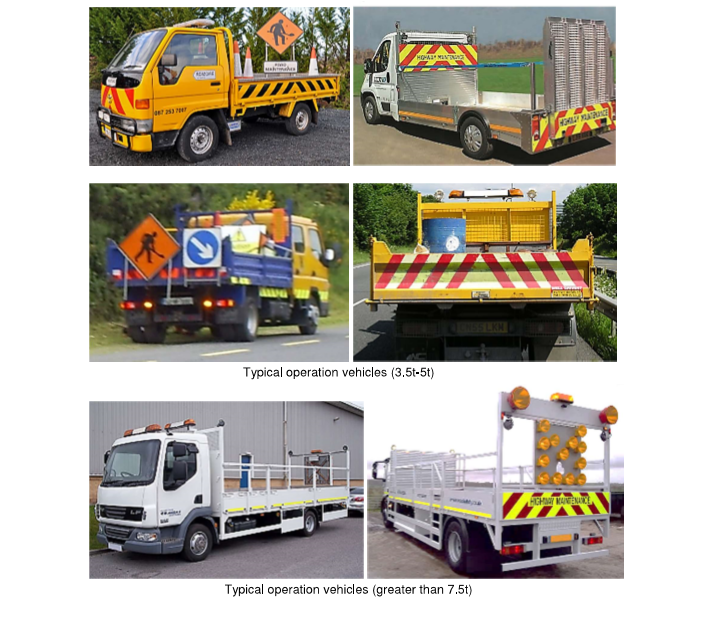
Larger IPVs are generally not used on lower speed single carriageway roads.
Vehicles and trailers must be maintained so that they are roadworthy and fit for purpose.
Reflective markings should be kept clean.
Beacons kept in full working order and they should be replaced if damaged or faded.
Towing equipment should be in full working order and checked regularly.
Pre-Commencement Requirements
Personal Protective Equipment PPE
Employers must ensure that PPE complies with the relevant standards.
PPE should be appropriate to the task to be undertaken and the level of risk.
PPE must be kept clean and in good condition and should be replaced when required.
High Visibility Clothing
High visibility clothing should be fluorescent yellow or orange with retro-reflective stripes.
Yellow or orange clothing may be more suitable for different site activities.
Clothing should always be fastened so that reflective bands can be seen and to maximize visibility to road users.
Class 2 (waistcoat or jacket) high visibility clothing must be worn on Level1 and 2 roads.
Class 3 ( jacket +trousers) high visibility clothing shall be used on Level 3 roads.
Safety Boots
Safety boots must be worn when on roadworks sites. They should have a steel toe cap and mid sole protection.
Hard Hat
A hard hat must be worn whenever employees are exposed to hazards that may result In damage or injury to the head or skull.
Specific areas where hard hats must be used include, but are not limited to:
- Construction, building or other areas designated as “Hard Hat Areas”;
- Areas where any crane, hoist, mobile elevated work platform, loader crane or other overhead lifting device is in operation
- Areas where there is a possibility of falling objects/debris, for example in excavations, beside the excavators, whilst loading vehicles etc.
- Machinery yards, storage areas, depots
- Areas where there is risk of falling from height, for example besides excavations and on rear of trucks.
Hard hats should fit correctly and be worn properly.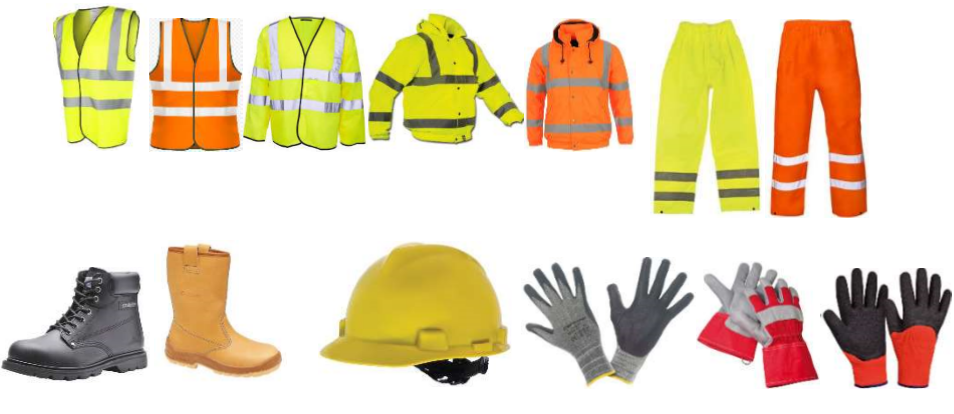
A chin strap should be used when working near fast moving traffic, working in high winds or beside excavations.
Hard hats should be changed when damaged and should be inspected regularly.
Hard hats typically last for between three and five years depending on how much weather exposure they have had, how they have been stored and how many knocks they have had.
Out of date hard hats must not be worn and must be replaced.
Gloves
Gloves should be worn on sites to protect operatives’ hands when handling signs and other equipment.
The type of gloves used should be suitable for the type of work being undertaken and should be a good fit for the user.
Effective Planning Checks for Temporary Traffic Management
The TTOS should confirm the Temporary Traffic Management Plan is acceptable for the task. Key items for ensuring this include the following.
A Temporary Traffic Management Plan (TTMP) should:
Take account of the site location and clearly highlight local constraints such as road widths, junctions, house entrances and services;
Clearly show the proposed traffic control system;
Clearly show how road users should get through/around the works;
Take account of local events or other activities in the vicinity of the site; and
If a standard TTM layout plan is being applied, identify the correct plan to be used.
A Safe System of Work Plan SSWP and Risk Assessment RA should:
Be done at the start of each activity;
Provide information on the work activity to be undertaken and the required resources;
Identify the hazards present on site;
Identify the specific controls to be put in place;
Act as a check that appropriate controls are in place before work begins;
Be communicated to and be signed by all persons attending site; and
Be reviewed at any time during the work if conditions change.
Site Induction
A Site Induction is a short safety talk usually given by a TTOS;
There can be two separate site inductions; the first given at the start of the works and then a second while on site. The second usually involves instructions given to operatives;
The aim of a Site Induction is to:
- Communicate the SSWP and TTM plan to attendees;
- Highlight specific hazards;
- Raise the awareness of attendees; and
- Inform them of the control measures put in place to prevent accidents.
It should be easily understood by those with either reading or language difficulties;
TTOS should keep it simple and encourage interaction with the attendees; and
TTOS should check the level of understanding by having a quick questions and answers session at the end.
There should be a sign off procedure of these checks with a record kept of the relevant paperwork.
General Principles of TTM Operations
Personal Safety
TTM operations should be designed, planned and implemented in a safe manner. General principles include the following:
Avoid working alone, if possible;
Do not become complacent; and
Recognize your own limitations and the limitations of your crew / colleagues.
Working on Foot
The number of operatives on foot required for installing, modifying and/or dismantling TTM operations should be kept to the absolute minimum necessary to complete the work.
Operatives should not run on site to reduce the risk of trips and falls and they should take care when climbing up and down side slopes to avoid slipping, falling or rolling onto the carriageway.
A delineated safety zone should be provided whenever practicable.
Workers on foot should not enter or undertake activities in a live lane at any time during the installation, maintenance, modification or removal of TTM.
Safely Crossing the Road on Foot
The location chosen to cross the road should have adequate visibility, in both directions if appropriate, and a place of safety at both sides of the carriageway.
Crossing the road should only be done when an adequate gap is available.
A traffic count should be carried out as part of a risk assessment for crossing the carriageway on foot.
When crossing the road on foot:
- See and be seen by traffic;
- Wait back from the edge of the live carriageway or protected by safety barriers or cones;
- Estimate safe gaps in the traffic;
- Only cross when a safe gap is present;
- Avoid road studs and trip hazards;
- Briskly walk straight across the road;
- Do not carry excessively heavy loads when crossing the carriageway;
- Do not run or zig-zag across lanes; and
- Do not feel pressurized into crossing when your co-workers do so. You are responsible for your own safety.
Carrying TTM Equipment
TTM equipment may be difficult to grasp. Operatives should take care when carrying TTM equipment so as not to endanger themselves, other workers or road users.
Carrying TTM equipment may restrict an operative’s vision, increasing the risk of slipping, tripping, falling or colliding with obstructions.
If an operative’s vision is affected by the load it may be useful for another operative to support the other end and therefore have a clear view.
Carrying of TTM equipment on foot across the live carriageway shall be done only when there is a suitable gap in traffic.
When carrying TTM equipment:
- Grip equipment securely;
- Ensure the load does not obscure high-visibility clothing;
- Ensure the load does not obstruct your view;
- Carry signs so as to reduce wind resistance;
- Ensure it is safe to cross the road;
- Do not show the front of signs to oncoming traffic.
Communicating with Road Users
Delays are often unavoidable and although they are within standard parameters, road users may get frustrated and TTM operatives may be subject to abuse.
TTM operatives should receive a site induction on how to deal with confrontational situations. TTM operatives should advise road users of the expected delay as this should alleviate any potential frustration and aggression towards the TTM crew.
Using TTM Equipment – Storage, Deliveries, Loading and Unloading of TTM Equipment
Equipment should be stored so that it does not get damaged easily.
For example, damaged sign legs may interlock with one another, making it difficult to load or unload signs.
Sand bags, batteries and other equipment should be stored in a dry location.
Also temporary traffic signals and radios should be charged.
The order of loading TTM equipment should be planned to avoid unnecessary unloading delay.
TTM equipment is normally loaded in the reverse order of how it will be unloaded and operatives should select which side of the vehicle will be away from live traffic on site.
Transport to Site
The condition of TTM equipment should be inspected before being loaded on to the vehicle in the yard.
Only equipment that is in an acceptable condition should be used.
The TTM equipment should be loaded onto the TTM vehicle so that it can be unloaded in an order that matches the setting up sequence.
TTM Equipment should be secured so that it does not become dislodged during transport to site.
Do not stack cones more than 25 cones high on the back of the TTM vehicle.
Delivery vehicles should be parked safely without restricting the visibility of road users.
Where TTM equipment is being delivered to multiple locations, do not travel on the rear of the vehicle between stopping points and ensure the load is secured between stopping points.
Loading and Unloading of TTM Equipment
TTM operatives should park safely and use designated zones for unloading and loading where provided.
Unacceptable TTM equipment must not be used.
When loading or unloading equipment:
- Order of loading equipment required;
- Get out of non-live side of vehicle;
- Do not load/unload equipment from the live traffic side of the vehicle;
- Load/unload TTM equipment without delay;
- Point sign legs away from traffic if laid down for re-use; and
- Check and record condition of equipment.
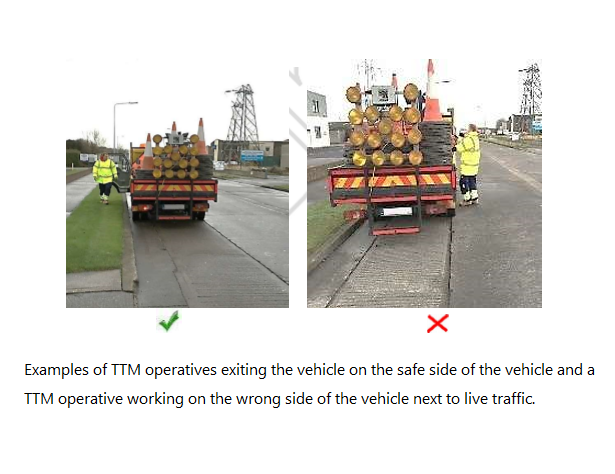
Securing Equipment
TTM operatives should secure signs so that they do not pose a hazard to road users or road workers.
The sign frame should be placed on a firm level footing. Four sand bags should be placed on the lower two sandbars of A frames and not on upper frames.
For frames where sandbars can’t be used, place a sandbag at the base of each frame leg.
Sand bags should not be used to secure cones.
Vulnerable Road Users
Pedestrians: Pedestrians must be protected from the works and vehicular traffic by providing a footway.
Temporary footways should:
- Be delineated with pedestrian barriers;
- Be delineated from vehicular traffic with a pedestrian barrier and traffic cones;
- Be clearly signed;
- Have a good quality, even surface, example compact material, tarmac, timber planking; and
- Include ramps where a kerb or other obstruction is crossed.
During roadworks operations:
- Footways must be kept clear of mud and debris;
- TTM operatives must not create obstructions on the footway such as when pulling cables from a coil;
- Open chambers, excavations etc. must be guarded at all times; and
- Unattended hazards must be covered, plated over or protected by barriers.
Cyclists
To the extent possible, the temporary cyclist route provided at roadworks should mirror the permanent arrangements if practicable.
Changes to cycle tracks should be clearly signed well in advance of the roadworks.
Temporary cycle facilities should:
- Be defined from the works area with barriers;
- Be clearly signed;
- Have a suitable even surface – plywood should not be used; and
- Be kept free of hazards such as potholes, gullies and cable protectors etc.
During roadwork operations:
Operatives should not place equipment, vehicles or materials in the temporary cycle facility;
The facility should be kept clear of debris e.g. loose gravel, broken glass, wet leaves; and
Operatives should ensure equipment does not encroach on the facility.
People with Impairments
A pedestrian barrier that can be detected by a visually impaired person using a stick must be provided.
A pedestrian barrier should be installed around obstructions that restrict pedestrian flows or are accessible to pedestrians, whether or not pedestrians with impairments are expected at the location. Where required, provision should be made for people crossing the road.
Night-time Work
Traffic flows and other factors dictate that some TTM is conducted during the hours of darkness.
Traffic flows are generally reduced while working during the night.
However other factors, such as poor driver behavior, higher speeds, fatigue, difficulty in judging distances and limited visibility, increase the risks of working during the night for road workers and road users.
Daylight checks before night-time work:
- Identify vehicle stopping points;
- Propose locations for signs, tapers and coning;
- Check verges for hazards;
- If possible, pre-place signs during daylight;
- Check crossing point visibilities;
- Identify any overhead lines.
TTM operatives should ensure that road users are sufficiently warned of TTM and are clearly guided past or through the works throughout hours of darkness.
Lamps, rotating reflectors or reflective strips should be installed on barriers to highlight their presence.
Unattended Works
TTM operatives should remove as many hazards as possible from the site before it is left unattended with all plant and machinery removed or secured.
Materials and equipment left on site should be secured or stored so that it cannot fall or be tampered with by the general public.
Continuous barriers should be erected around the site to ensure that pedestrians do not enter.
The size of the works area should be reduced when unattended and made safe, secure and stable.
Sites that are unattended still require the TTM to be routinely checked and maintained. Where TTM cannot be removed, TTM should be reduced.
Other Factors / Restrictions
Weather Conditions
Weather conditions need to be taken into account including wind, rain, fog, and low sun.
Weather forecasts should be consulted to confirm the likelihood of satisfactory visibility throughout the operation.
Operatives should be aware of the effects of adverse weather, such as reduced visibility in fog or heavy rain, increased stopping distances, the reflective glare of sunlight on a wet road surface and dazzle from a low sun.
TTM signs and frames should be stabilized with ballast in the form of sand bags or secured to permanent fixtures.
During the course of the works consideration should be given to the possibility of removing the TTM in order to deal with adverse weather conditions.
If poor weather conditions persist it may be necessary to stop work and to clear the site of all personnel in the interests of their safety.
TTM operatives should be informed of any risks due to restricted road widths, and of the measures in place to reduce the associated risks.
Additional care should be taken when working on roads with no hard shoulders.
Traffic Speed and Queue Management
Traffic speeds should be monitored, particularly where relying on lower speeds to use reduced lateral safety zones.
Works that reduce the number of traffic lanes on busy commuter routes should be avoided at anticipated peak times.
Advance signage should be checked and, if necessary, adjusted to ensure that road users are warned of queues.
If significant queues are present due to the TTM in place, then a review of the type of TTM system or operation should be carried out and a decision made whether to change to a different system.
Principles of Setting-Out and Placing TTM Equipment
Look at the Temporary Traffic Management Plan (site specific/ standard TTM layout). Look at the cross section. How are you going to apply the TTM Plan?
Decide where to start and end safety zones, tapers.
Decide where the advanced signage is going to be placed.
Road Widths
Where adequate lateral clearance cannot be provided due to restricted road width, the following options may be considered:
If appropriate, the road may be closed and traffic diverted along a suitable diversion route;
A convoy system may be put in place – a lateral safety zone is not required when a convoy system is in place; or
Traffic speed to be reduced to 20km/h, using physical safety measures in association with enforcement of the speed limit where appropriate.
The TTOS must ensure that lane widths are maintained as per the tables below.
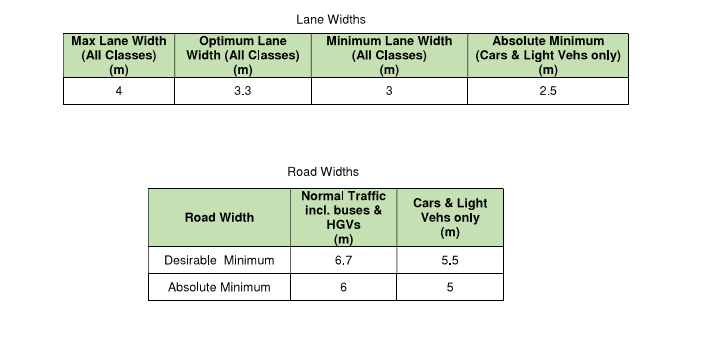
Lana Widths where Cyclists are to be accommodated
The following is a summary of recommended lane widths at roadworks where cyclists share the running lane with vehicles.
Lane Width (m) Comment and Recommendation
<3.3 Consider using ‘Narrow lane: do not overtake cyclists’ sign
3.3 to 3.5 Too narrow for drivers of large vehicles to overtake but cars can pass cyclists
3.5 to 4.0 To be avoided
>4 Wide enough for all vehicles to overtake
Lane widths greater than 4m should be monitored to ensure vehicle speeds are not excessive through the site.
The installation of maximum lane widths may require additional cones on other side of road.
Where the works area is less than 10m in length, a 3.3m lane width is sufficient as traffic would be delayed by a cyclist for only a short period of time and therefore driver frustration would not be an issue.
Where the works area is greater than 10m in length, a 4m lane width should be provided to allow a driver to overtake a cyclist and therefore reduce driver frustration.
Cyclist Facilities on Rural Roads with Hard Shoulder
Subject to a risk assessment, a temporary cycle facility may be required where a hard shoulder on a rural road is closed as part of the roadworks.
Visibility Requirements
Operatives should ensure they are clearly visible to road users and other operatives at all times. If you cannot see traffic, then traffic cannot see you.
Drivers approaching the site should have good visibility of the temporary route through the site.
The road user should have visibility to the sign and of the sign face.
Minimum visibility to TTM signs is as follows:
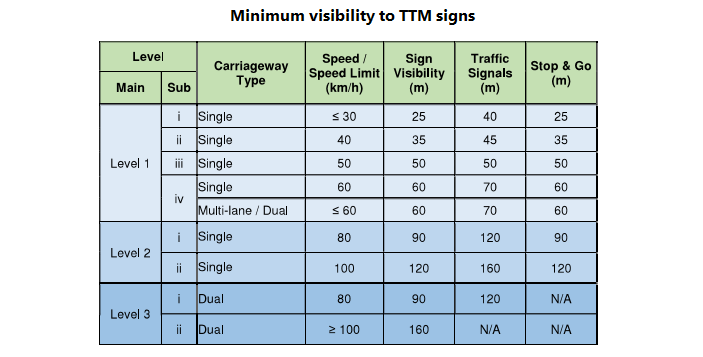
Additional Advance Warning Signage should be provided if there is reduced visibility on the approach to the proposed works site.
Examples include works on a bend, on a dip in the road, on the brow of a hill or at times of adverse weather.
This additional signage will need to be placed first.
TTM operatives should not start work if visibility is poor or during adverse weather conditions, except in an emergency.
Location for Flagmen / Operatives
The Flagman / Operative should stand at the head of the advance central coning approximately 20m away from the start of the lead-in taper.
A safe area should be made available in which to locate the Flagman at this point.
A safe area should have the following:
- Visibility;
- Safe refuge: and
- Escape route.
Pick a location that is safe, for example a gateway.
If a gateway is not present and works are adjacent to a wall, then a build out should be constructed using cones.
It is essential that the minimum visibility distance to the flagman is maintained and the flagman is not positioned around blind bends, parked vehicles, in dips or hidden by hedgerows or street furniture.
Flagmen have a responsibility to be positioned in advance of these hazards rather than follow the operation at a fixed distance behind. This distance may range from 50 to 215m depending on the stopping sight distance required.
Dealing with Conflicting Permanent Signage
Where TTM signs conflict with permanent signs, the following procedure applies:
The Local Authority’s permission must be obtained to cover, alter, or remove an existing sign;
There are three ways to deal with a conflicting sign;
- Remove it;
- Cover it – ensuring not to damage the sign face. The cover should be fit for purpose, durable, and suitable for the weather conditions; and
- Mask it (using masking spray).
Upon removing the TTM, all signs that have been covered or removed should be reinstated immediately ensuring that they are not damaged in the process.
Post Installation Review
Design Objectives
The two primary objectives of the TTM Plan are to:
Keep uncontrolled traffic separate from the workforce; and
Let the road user know what is happening and what is expected of them. When the TTM plan is installed, these two items must be achieved.
Dynamic Risk Assessment
Dynamic risk assessment (DRA) is the continuous process of on-site assessment and identification of hazards, assessing risks and taking actions to remove or reduce these risks.
This is particularly relevant where site circumstances change.
A DRA is often in addition to standard and SSRAs.
It can be reviewed or updated at any time during the works and can form part of the SSWP and it equates to the ongoing reviewing of the SSWP.
It also ensures that the TTM plan continues to be fit for purpose.
Items that should be taken into account during monitoring and control include the following:
- Fading light;
- Low sun;
- Vehicle breakdowns or faulty TTM equipment;
- Changing traffic conditions; and
- Changing weather conditions.
Then carry out the following:
- Evaluate the situation and identify the hazards;
- Ensure the benefit justifies the risk taken to execute the action; and
- Make amendments if required and continue if it is still safe to do so.
TTM Operation Methods – TTM Installation
The sign installation sequence may vary depending on the road type and TTM required.
The following methods should be complied with during the TTM installation.
Work within the coned off area and work facing oncoming traffic.
Use work vehicle(s) to protect yourself from errant vehicles, work on non-live traffic side of the vehicle and allow for potential shunting.
When installing use footway, verge or hard shoulder when travelling on foot.
Where it is necessary to put signs on a footway, sufficient space should be left for pedestrians to pass.
Signs and equipment should be positioned where they are not hidden by other signs, vegetation, etc. and do not pose an undue risk to pedestrians or other road users.
Secure signs and equipment with sand bags unless works are short-term duration.
Temporary signs should not interfere with permanent signs.
Remove or cover existing permanent signs that contradict temporary signage.
TTM Maintenance and Inspections
Regular maintenance and inspections should be carried out to ensure that the TTM layout is fit for purpose, is correctly installed and is in a satisfactory condition.
This section outlines the requirements for TTM maintenance and inspections.
TTM Maintenance
Signs, cones and any other equipment or road markings should be maintained and checked regularly.
As part of planning, sufficient resources should be made available to carry out checks and maintain the TTM in a safe condition.
Damaged equipment should be replaced as soon as possible.
Operatives should work within the coned off area and work facing oncoming traffic.
Inspections
Inspections should be carried out by the TTOS or a competent person designated by the TTOS.
The frequency of inspections may vary from site to site. Sites with higher traffic volumes should be inspected at more frequent intervals. This is also the case during bad weather.
Inspections are critical where works are ongoing overnight and/or over weekends.
Inspections should note whether or not the site is operating as per the TTM plan and should set out actions to rectify any issues identified.
Inspections should include the following items:
- Review of site details;
- On-site hazards and particular risks such as power lines;
- Review of specific control measures;
- Ensure that appropriate controls remain in place.
TTM Modification / Phase Changes
TTM modifications typically refer to unplanned changes that may be required to fix issues identified during inspections on the TTM layout.
Phase changes are normally planned changes to the TTM layout where a phase of works is complete and the TTM is then switched from one lane/location to another.
The following principles should be followed where modification or phase changes are required.
A three day cardholder must be on site when modifications are made to the TTM layout.
Operatives must work within the coned off area and work facing oncoming traffic.
Remove signs and equipment that are no longer required and store safely, ensuring they do not obstruct pedestrians
Do not lay redundant signs flat on the ground as they may become a trip hazard. The general public could pick them up, thinking they have been knocked over.
TTOS should carry out a check or drive-through when changes are made.
TTM Audits
Audits are carried out to ensure that requirements relating to TTM are properly applied.
The following items provide further information on audits of TTM layouts.
Employers / Organizations should have an audit regime in place.
Audits should be carried out by a suitably qualified person that is not directly involved in the roadworks or the TTM design, such as a line Manager or Health and Safety Officer.
The frequency of audits is dependent on the duration of the roadworks, see below table for details.
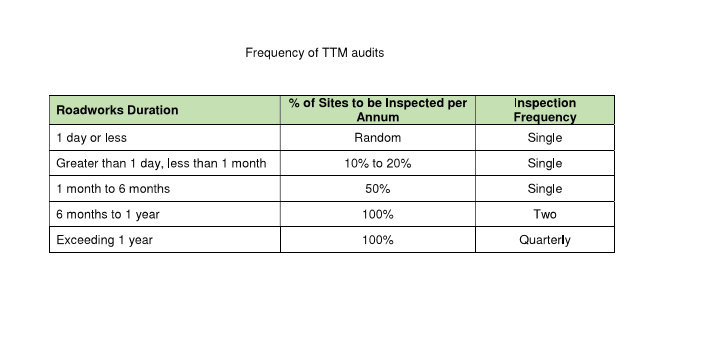
TTM Removal
The following principles should be followed when removing TTM.
Construction work should be complete before removal of TTM equipment begins.
Removal of TTM equipment should be coordinated with other activities on site.
TTM equipment should be removed in a linear operation working from the end of the roadworks signage.
The Roadworks Ahead sign should be the last sign to be removed.
Operatives should work within the coned off area and work facing oncoming traffic.
Removal of TTM equipment should be done promptly so that road users are not confused.
TTM equipment should be carefully loaded on to the non-live side of the vehicle.
TTOS should carry out a check or drive-through when removal of equipment is done.
Discover more from Project Management 123
Subscribe to get the latest posts sent to your email.